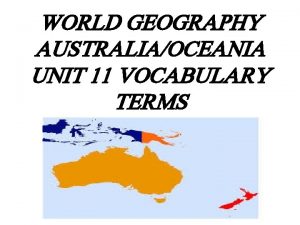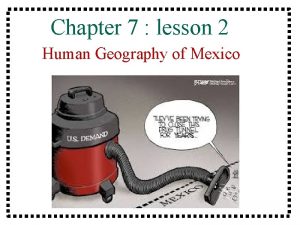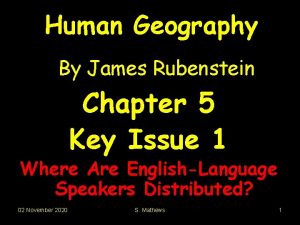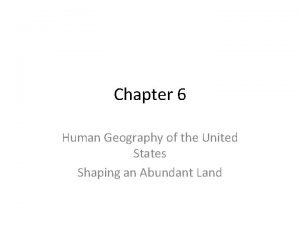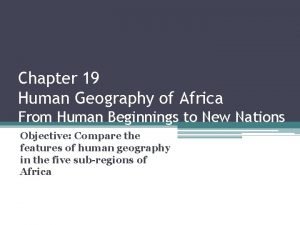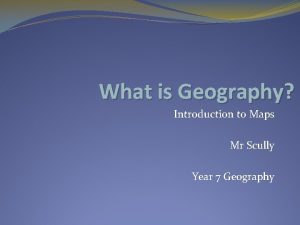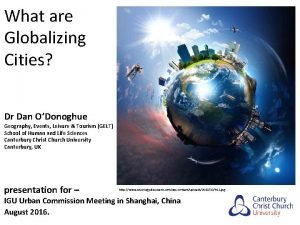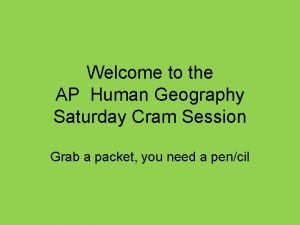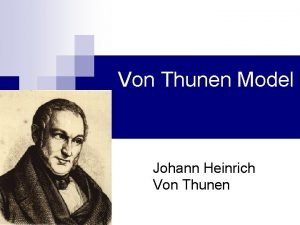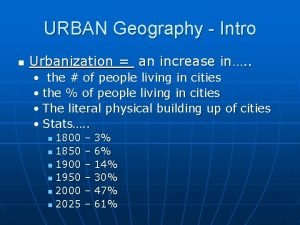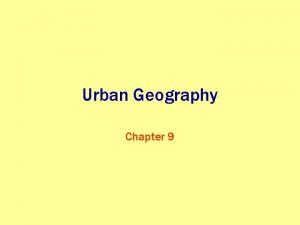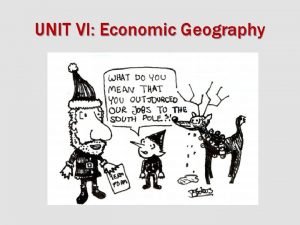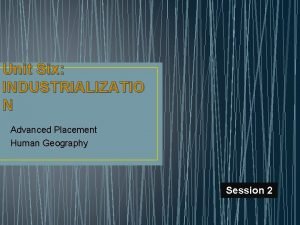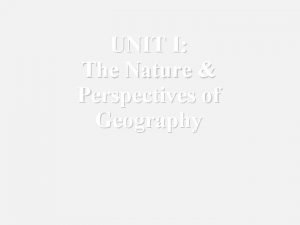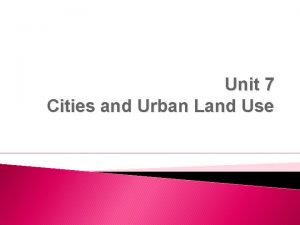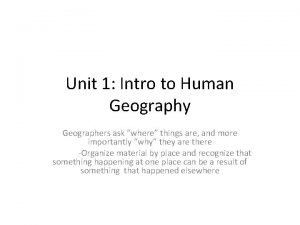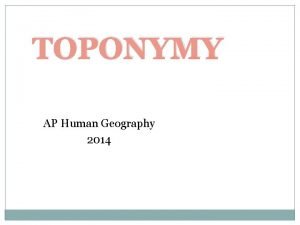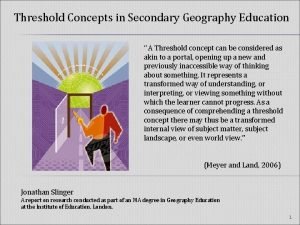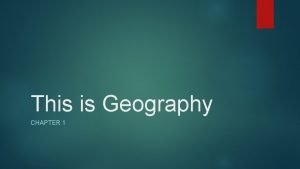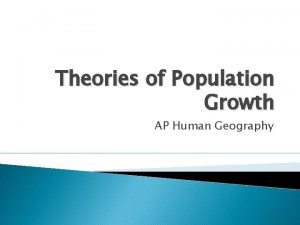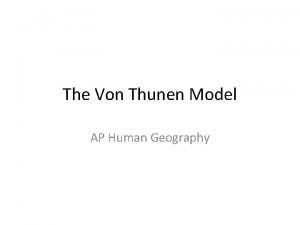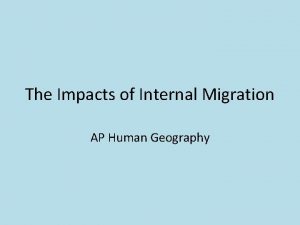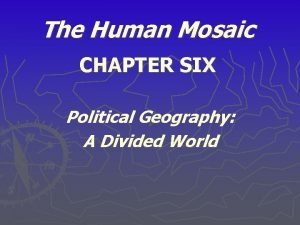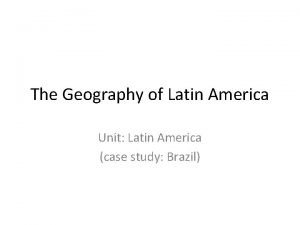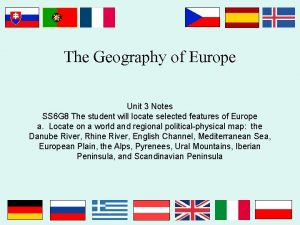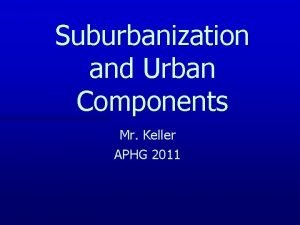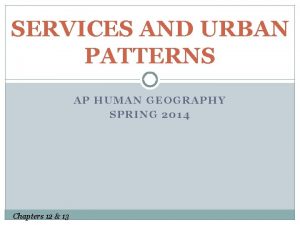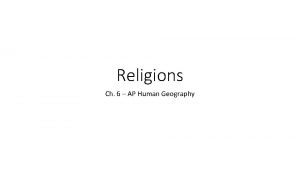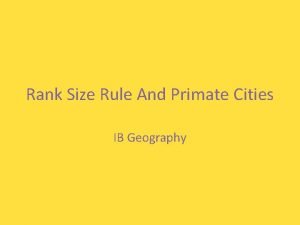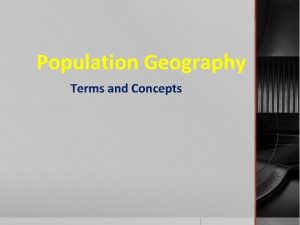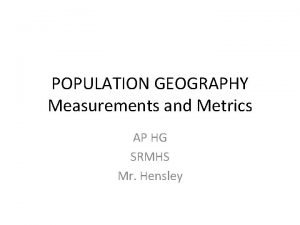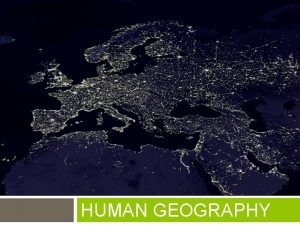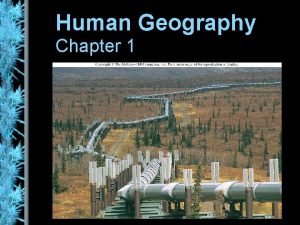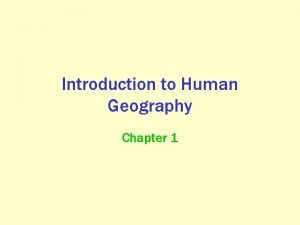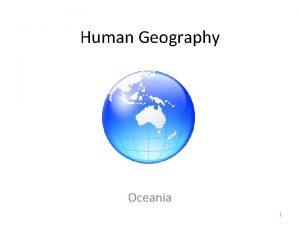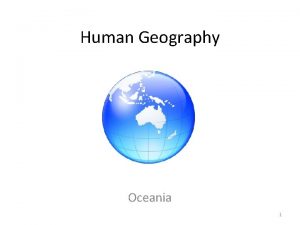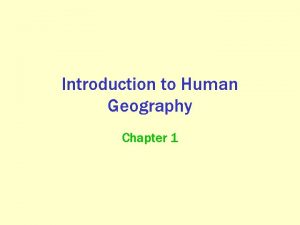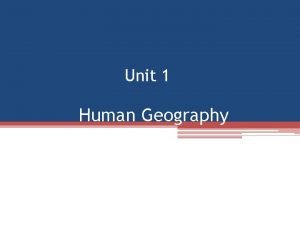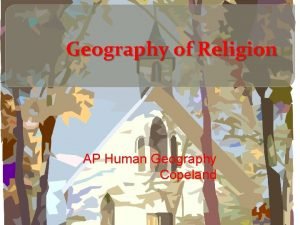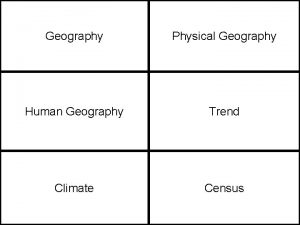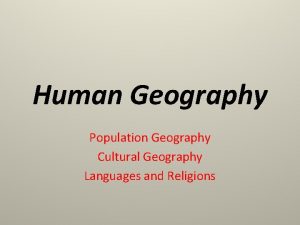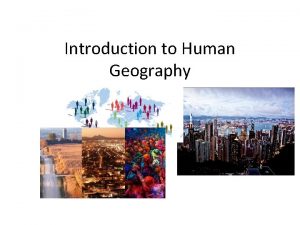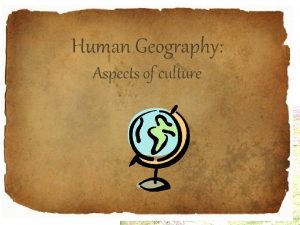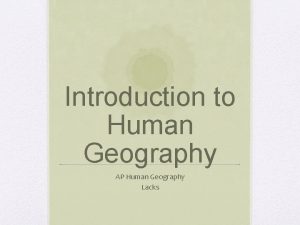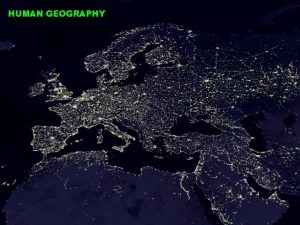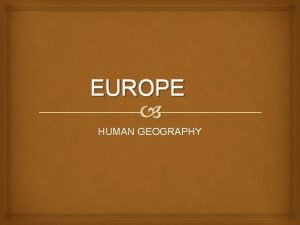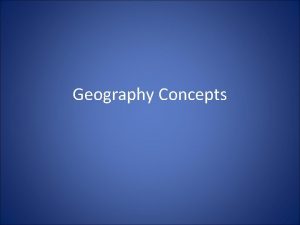Human Geography Chapter 1 what is geography description























































- Slides: 55

Human Geography Chapter 1

what is geography? • “description of the earth” • a study of spatial variation – the how and why of physical & cultural differences – location, location – observable patterns that have evolved through time

-interaction of physical environment and human activity -cultural landscape can alter the natural environment

evolution of the discipline - mapping/human interpretation • Aristotle (384 -322 BC)-earth is spherical • Erathosthenes (276 BC)-Greek scholar”geo”=earth “graphy”=to write • Strabos (63 BC-24 AD)/Herodotus (484423 BC)

Ptolemy nd (2 century AD)

outside the western world • Chinese Scholars • Muslim Scholars

• • Where are people? What are they like? What is their interaction over space? What kinds of landscapes do they erect? human geography

physical geography • attention towards natural landscape – landforms and their distribution – atmospheric conditions and climatic patterns – soils / vegetation associations

modern geography…. . • 1. Climates, patterns, processes of physical environment • 2. Rapid development of natural sciences • 3. Accurate mapping • 4. Data collection / statistics

academic geography • • Earth science Man-land relations Areal differentiation Spatial organization – – – location processes patterns interactions/relations distributions

three concepts about space • Location • Direction • Distance

absolute location • Mathematical location – Latitude & Longitude • degrees, minutes, seconds – Township & Range (1785 Land Ordinance) • Subdivision: parallels & meridians • Topographic quadrangle, US Geological Survey – Metes & Bounds

latitude & longitude (22° 15' N, 114° 10‘ E)

relative location • “place” in relationship to surroundings

• Site – absolute location concept – physical & cultural characteristics • Topography, vegetation, water, physical characteristic

• Situation – external relations of locale – relative location concept – dynamic

absolute directions • Based on cardinal systems – north, south, east, west – from solar system

relative directions • Based on cultural & local perceptions – no absolute boundaries or definitions – “down south”, “out west”, “up north”, “down south”, “Near East”, “Far East”

absolute distance • Absolute mathematical mileage, or measurement of distance

relative distance • Refers to a more regional spatial relationship – how distance is described $$$ & TIME MILES MINUTES

psychological distance • Distance lengthened / shortened – first time traveled – night / day travel – safety / danger / excitement

size & scale • Size of unit studied • Scale implies degree of generalization – broad or narrow – Varying sizes • local • regional • global

landscapes • Natural • Cultural • Dynamic

multi-varied landscapes

process of change Before 1970 After development Long Island, New York

spatial interaction • Accessibility – how easy/difficult to overcome & space separation • Connectivity – how places are connected • Spatial diffusion – process of dispersion of ideas or items from a center of origin to more distant points • Globalization – Increasing interconnection of peoples and societies worldwide time

globalization • Standardization – $$$$, EU, time, United Nations • Containerization – movement of products – outsourcing • Intersection of the ‘haves’ & ‘have nots’ – cell phones, internet

spatial distribution • Arrangement of items on Earth’s surface • Three concepts

1. density • Measure of the number/quantity within a defined unit of areas – proportion • arithmetic • physiological density

2. dispersion (concentration) • Amount of spread of phenomenon over an area – 1. clustered, agglomerated – 2. dispersed, scattered, random

3. pattern • Emphasizes design rather than spacing – linear (a) – road, river, rail line – centralized (b) – city & suburbs – random (c) • Rectangular system of land survey - U. S. – rural: checkerboard, 1 mile squares – cities: grid system

regional concepts • 1. formal or uniform regions – Areas of essential uniformity • Physical or cultural • Sahara Desert, “Bible Belt”

2. functional region • spatial system defined by interactions/ connections Glendale Galleria Newspaper Route

3. perceptual regions • Less structured & more culturally based China Town The “Valley’

cartography – the science of making maps • Maps provide a visual tool • Maps are subjective • Map projections transfer locations on a round surface to a flat surface – some form of distortion always occurs – greater distortion results from larger areas depicted

global grid system

mathematics of the Earth • Aristotle (384 -322 BC) discovered the earth to be an oblate spheroid – Equatorial bulge 7926. 38 (7924) – Polar shortening 7899. 80 (7922) – 23. 5° axis (tilt)

seasons and climate • Earth’s rotation & movement around the sun • Tilt of the earth’s axis (23. 5°) • Receipt of solar radiation • Re-radiation of energy in the form of heat

the Earth’s divisions • Latitude lines – Equal distance between lines – Lines become increasingly smaller descending from the equator to poles • Longitude lines – Each line is the same exact length – All lines become increasingly close together as they descend to the poles

important lines of latitude • • • Equator: 0 degrees Tropic of Cancer: 23. 5 degrees North Tropic of Capricorn: 23. 5 degrees South Arctic Circle: 66. 5 degrees North Antarctic Circle: 66. 5 degrees South


important lines of longitude • Prime Meridian: 0 degrees (runs through Greenwich, England) • International Dateline: 180 degrees • Time Zones: every 15 degrees of longitude equals one hour



maps • Scale – the smaller the scale the greater the detail - for example one inch = mile is more detailed inch = one miles 1: 1 or 1: 100 • Legend – interprets map information one than one hundred

map projections & distortion • • Shape Distance Relative size Direction


Robinson map projection

Fuller’s Dymaxion projection

Topographical map

Thematic maps

Cartogram map

Geographical Information Systems


mental maps
 Frq ap human geography format
Frq ap human geography format 5 themes of geography ap human geography
5 themes of geography ap human geography Proruption ap human geography
Proruption ap human geography Human development index definition ap human geography
Human development index definition ap human geography Ap human geography chapter 11 vocab
Ap human geography chapter 11 vocab Chapter 16 section 1 russia and the western republics
Chapter 16 section 1 russia and the western republics Chapter 22 human geography of southwest asia
Chapter 22 human geography of southwest asia Chapter 11 ap human geography
Chapter 11 ap human geography What influenced mexico’s political and social structures
What influenced mexico’s political and social structures Renfrew theory ap human geography
Renfrew theory ap human geography Chapter 13 human geography of europe
Chapter 13 human geography of europe Received pronunciation definition ap human geography
Received pronunciation definition ap human geography Why is the united states called a postindustrial economy
Why is the united states called a postindustrial economy Chapter 25 human geography of south asia
Chapter 25 human geography of south asia Chapter 19 section 1 east africa
Chapter 19 section 1 east africa Cna chapter 8 human needs and human development
Cna chapter 8 human needs and human development Chapter 8 human needs and human development
Chapter 8 human needs and human development Human rights description
Human rights description Leapfrogging ap human geography
Leapfrogging ap human geography Geography lines
Geography lines Alpha beta gamma cities ap human geography
Alpha beta gamma cities ap human geography Anocracy example ap human geography
Anocracy example ap human geography Least cost location
Least cost location Milkshed ap human geography
Milkshed ap human geography Thnen
Thnen Von thunen model
Von thunen model Township and range aphg
Township and range aphg Suburban sprawl definition ap human geography
Suburban sprawl definition ap human geography Clustered definition ap human geography
Clustered definition ap human geography What is the central place theory
What is the central place theory Brandt line
Brandt line Modernization model ap human geography
Modernization model ap human geography Nation state
Nation state The geographic grid
The geographic grid Urban sprawl ap human geography
Urban sprawl ap human geography Political organization of space
Political organization of space Distortion
Distortion Environmental injustice ap human geography
Environmental injustice ap human geography Toponym human geography definition
Toponym human geography definition Threshold definition ap human geography
Threshold definition ap human geography The geometric arrangement of objects in space
The geometric arrangement of objects in space Demographic transition model ap human geography
Demographic transition model ap human geography Von thunen model definition
Von thunen model definition The multiple nuclei model
The multiple nuclei model Remittances ap human geography
Remittances ap human geography Cleavage model ap human geography
Cleavage model ap human geography South america highlands
South america highlands Natural boundary ap human geography
Natural boundary ap human geography Territorial morphology
Territorial morphology Exurb definition ap human geography
Exurb definition ap human geography Gewandorf
Gewandorf Ap human geo topics
Ap human geo topics Primate city vs rank size rule
Primate city vs rank size rule Demographic momentum ap human geography definition
Demographic momentum ap human geography definition Nir ap human geography
Nir ap human geography Postmodern architecture ap human geography
Postmodern architecture ap human geography




